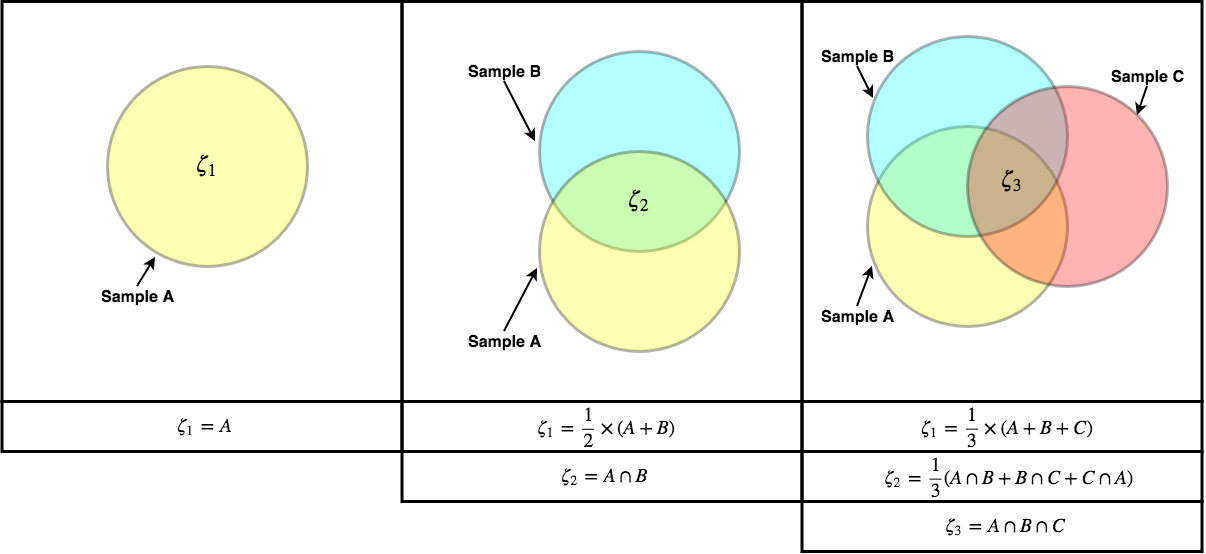Zeta diversity on:
[Wikipedia]
[Google]
[Amazon]
In

ecology
Ecology () is the study of the relationships between living organisms, including humans, and their physical environment. Ecology considers organisms at the individual, population, community, ecosystem, and biosphere level. Ecology overlaps wi ...
, zeta diversity (ζ-diversity), first described in 2014, measures the degree of overlap in the type of taxa present between a set of observed communities. It was developed to provide a more generalized framework for describing various measures of diversity, and can also be used to test various hypotheses pertaining to biogeography.
Zeta diversity as an extension of other measures of diversity

α-diversity
The most basic measure of community diversity,alpha diversity
In ecology, alpha diversity (α-diversity) is the mean species diversity in a site at a local scale. The term was introduced by R. H. WhittakerWhittaker, R. H. (1960) Vegetation of the Siskiyou Mountains, Oregon and California. Ecological Monograp ...
(α-diversity), can be described as the average number of distinct taxonomic groups (e.g. unique genera
Genus ( plural genera ) is a taxonomic rank used in the biological classification of living and fossil organisms as well as viruses. In the hierarchy of biological classification, genus comes above species and below family. In binomial nomenclat ...
or operational taxonomic unit
An Operational Taxonomic Unit (OTU) is an operational definition used to classify groups of closely related individuals. The term was originally introduced in 1963 by Robert R. Sokal and Peter H. A. Sneath in the context of numerical taxonomy, w ...
) present, independent of their abundances, on a per sample basis. In the ζ-diversity framework this can be described as ζ1, the number of unique taxa present in one sample.
β-diversity
Beta diversity
Beta (, ; uppercase , lowercase , or cursive ; grc, βῆτα, bē̂ta or ell, βήτα, víta) is the second letter of the Greek alphabet. In the system of Greek numerals, it has a value of 2. In Modern Greek, it represents the voiced labiod ...
(β-diversity) is a measure to allow for a comparison between the diversity of local communities (α-diversity). The greater the similarity in community composition between multiple communities, the lower the value of β-diversity for that set of communities. Using the number of distinct taxonomic groups per community as a measure of α-diversity one can then describe β-diversity between two communities in terms of distinct number taxonomic groups held in common between them. Given two communities, ''A'' and ''B'', a measure β-diversity between both communities can be described in terms of their overlap (ζ2) as well as the average number of unique taxonomic categories found in ''A'' and ''B'' (ζ1). In the framework of ζ-diversity we can then describe the average β-diversity, as described by the Jaccard index
The Jaccard index, also known as the Jaccard similarity coefficient, is a statistic used for gauging the similarity and diversity of sample sets. It was developed by Grove Karl Gilbert in 1884 as his ratio of verification (v) and now is freque ...
, for a set of samples as
Multi-site assemblages
The framework then for ζ-diversity can then be extended beyond measures of diversity in one (α-diversity), or between two communities (β-diversity), to describing diversity across sets of three or more communities. If ζ1 describes the number of distinct taxa in community ''A'', and ζ2 describes the number of distinct taxa held in common between communities ''A'' and ''B'', then ζn describes the number of distinct taxa held in common across n communities.References
{{Reflist Measurement of biodiversity